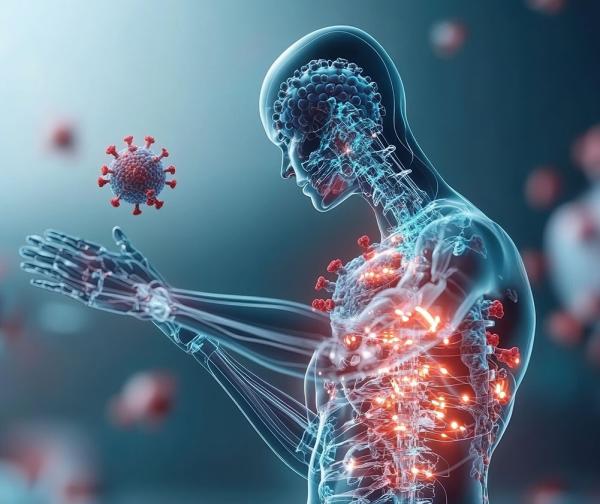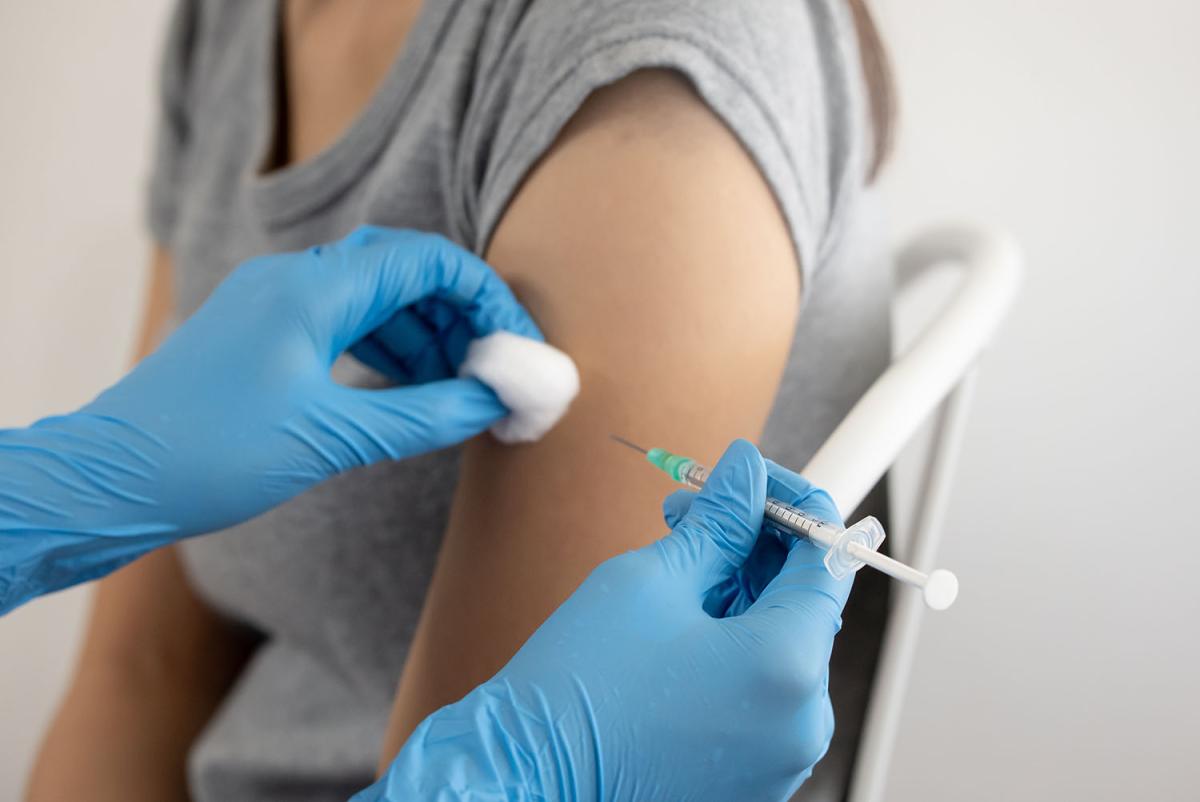COVID-19 Causes Persistent Protein Perturbations
New IRP Research Hints at Possible Culprits Behind Long-COVID

A deep dive into how COVID-19 affects the levels of thousands of proteins in the blood revealed that the virus causes long-lasting changes in the abundance of hundreds of proteins.
Nearly five years after COVID-19 first raged across the United States, most people have some immunity to the disease through vaccination or a prior infection. However, COVID not only remains a continued threat to vulnerable individuals, but also has saddled some patients with lasting symptoms. New IRP research provides a starting point for better understanding that ‘long-COVID’ phenomenon by identifying an array of substances in the blood whose levels are abnormal months after people catch the illness.1
Our bodies are constantly manufacturing a huge variety of proteins that are responsible for maintaining business as usual. Many of these proteins eventually find their way into the blood, forming a ‘proteome’ that can be analyzed by scientists to learn about any systems that might be behaving strangely in a person’s body.
“They kind of tell you about general health,” explains IRP senior investigator Anthony F. Suffredini, M.D., the new study’s senior author. “Obviously, when we go see a physician, they’ll do a health assessment looking at different markers of disease, but it’s a much deeper entity than that. The methodologies that have come along in the last five or six years have dramatically changed the way we think about the proteome so that we don’t just measure the usual suspects. We can measure thousands of proteins now, and you can put that information into databases that tell you that you have, say, 30 proteins that are related to the activation of a certain type of cell or that tell you a certain process is occurring.”

Dr. Anthony Suffredini
Dr. Suffredini is one of several IRP researchers leading a long-term effort to examine COVID-19’s effects on a set of vaccinated and unvaccinated people who had mild or moderate COVID symptoms and visited one of two hospitals in Maryland and Washington, D.C., between May 2020 and June 2022. The IRP researchers and their collaborators at those hospitals conducted a variety of exams on those individuals as well as healthy people on multiple occasions spaced months apart, including taking blood samples. The new study used those blood samples to examine how COVID altered the participants’ proteomes not only during their initial infections, but also months later.
“I think that it can begin to help identify molecules that might potentially be associated with not only long-term effects, but also the process of recovery,” Dr. Suffredini says. “By looking at so many proteins, you’re able to widen your horizons.”
Indeed, the IRP researchers looked at more than 7,000 different proteins and discovered that the amounts of nearly 2,000 of them in the blood were different in the study participants who had COVID compared to those who did not. For instance, during the initial infection, more than 550 proteins were present in higher amounts in the blood of unvaccinated patients, compared to just under 100 in vaccinated people. Some of these proteins signaled, as expected, that the vaccinated participants’ immune systems were able to leverage the knowledge of the virus they acquired from the vaccine to activate a more effective and less damaging immune response than the unvaccinated participants.
“Because they’ve already had a previous exposure to the viral products through the vaccine, they’re already set up to respond to it appropriately, whereas the unvaccinated people are basically at square one,” Dr. Suffredini says.
Even more proteins had reduced levels in people with COVID compared to healthy individuals — just over 1100 in unvaccinated patients and nearly 800 in vaccinated people. The affected proteins are known to play a role in a number of important processes, including cells’ intake of nutrients; the transportation of materials inside cells; the management of ‘filaments’ that support cell structure and movement; and the production of new blood vessels, as well as regulating how permeable blood vessels are. This last finding is particularly interesting given that COVID can cause life-threatening blood clots.

The IRP study’s findings re-emphasize the effectiveness of COVID vaccines, as the virus altered levels of fewer proteins in the blood of vaccinated patients compared to unvaccinated people.
What’s more, the levels of many proteins did not return to normal over the months following the participant’ bouts with COVID. Ten months after the initial infection, the levels of 53 proteins remained elevated in the blood of unvaccinated people, compared to 25 in vaccinated participants. On the other hand, nearly 770 proteins had reduced levels ten months post-infection in unvaccinated people, and the same was the case for more than 600 proteins in vaccinated patients.
“We were surprised that after nine to ten months, you still have changes that have resulted from you being infected,” Dr. Suffredini says. “The majority of the patients that we had in our study were not people in the intensive care unit. About a third were moderately ill and required oxygen during their hospitalization. Still, even after 10 months, the proteins in their blood were not back to normal.”
“Many of the earlier studies using similar techniques didn’t really talk about this,” he adds. “I think these lasting changes were under-appreciated. Often what we don’t understand we don’t want to talk about, but we couldn’t ignore it because this is quite real, and it was still lurking even way after an initial infection.”

The study’s findings may help identify some of the culprits behind the persistent fatigue, brain fog, and other symptoms some patients continue to experience long after recovering from a COVID infection.
Dr. Suffredini and other researchers can now dig deeper into these findings to identify proteins that might warrant further study on their relationship to long-COVID. For example, the study identified several proteins found at higher or lower levels in people who showed signs of lung inflammation and scarring ten months post-infection, as well as proteins whose abundance was statistically associated with persistent neurological, cardiovascular, or muscular symptoms. Learning more about how COVID-19 affects such proteins could eventually lead to new ways to help patients with long-COVID.
“I think our study provides a little bit of underpinnings for thinking about long-COVID and other post-infectious syndromes that have long-term consequences — not just with COVID, but with influenza or mononucleosis, and there’s even lasting effects with Ebola and dengue and other viral infections,” Dr. Suffredini says. “It’s part of the puzzle. It doesn’t provide an answer, but I think it makes us much more sober about what we think we know.”
Subscribe to our weekly newsletter to stay up-to-date on the latest breakthroughs in the NIH Intramural Research Program.
References:
[1] Huapaya JA, Gairhe S, Kanth S, Tian X, Demirkale CY, Regenold D, Sun J, Lynch NF, Luo R, Forsberg A, Dewar R, Rehman T, Li W, Krack J, Kuruppu J, Aboye EA, Barnett C, Strich JR, Davey R, Childs R, Chertow D, Kovacs JA, Torabi-Parizi P, Suffredini AF. Alterations in the plasma proteome persist ten months after recovery from mild to moderate SARS-CoV-2 infection. Front Immunol. 2024 Sep 11;15:1448780. doi: 10.3389/fimmu.2024.1448780.
Related Blog Posts
This page was last updated on Tuesday, November 12, 2024
